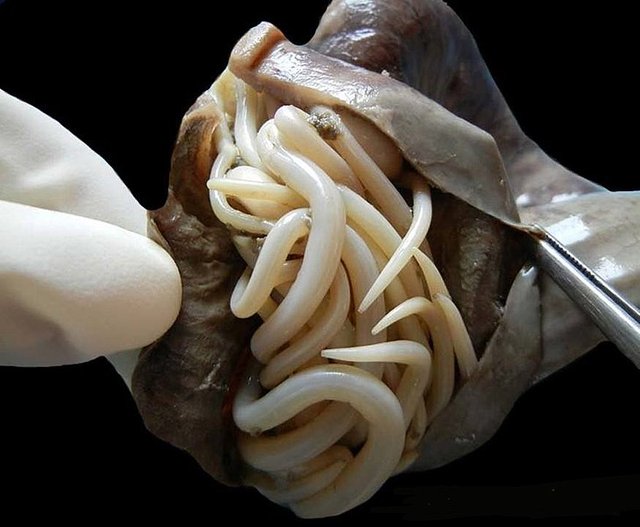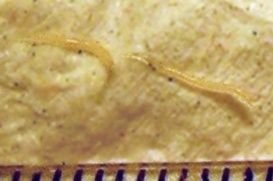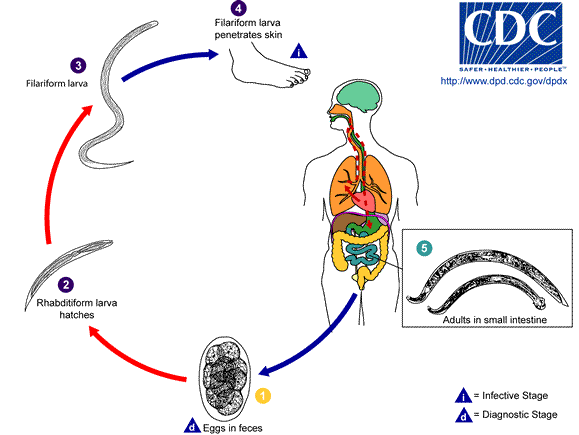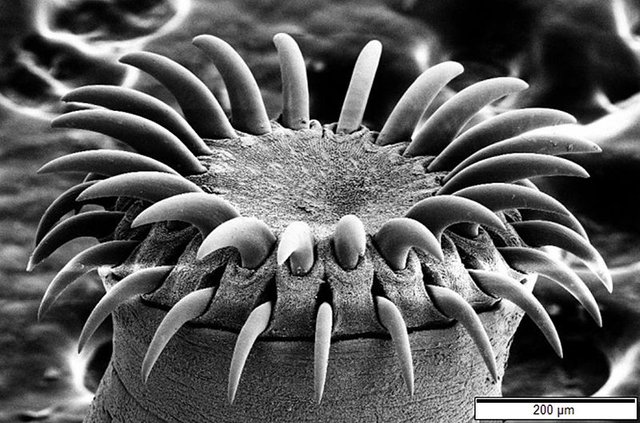Worm is a generally common name for various unrelated invertebrates animals, with soft and slender bodies which are grouped into the phyla: Annelida, Arthropoda, Chaetognatha, Sipuncula, Gnathostomulid, Onychophora, Hemichordata, Nemertea, Nematoda, Nematomorpha, Priapulida, Phoronida and Platyhelminthes.
They belong to the
kingdom-Animalia and
Subkingdom-Eumetazoa.
.png)
In other to make it more easier to understand, I would begin with definition of some terms.
Definition of useful terms.
Phylum:(plural phyla), A rank in the classification of organisms, below kingdom and above class; also called a division.
Annelid: any of various wormlike animals, of the phylum Annelida, having a segmented body.
Parasite: An organism that is entirely dependent on another organism known as the 'host', for all or part of its life cycle and food necessities.
Host: An organism which harbours or shelters a parasite, and provides nourishment to it.
Arthropod: An invertebrate animal having an exoskeleton, a
segmented body, and paired jointed appendages.
Reptiles: A cold-blooded vertebrate of the class Reptilia.
Amphibians: Animal of the Amphibia, that does not have amniotic eggs, living both on land and in water.
.png)
ABOUT WORMS.
Vincent Of Beauvais in his mirror of nature, recognized worms as a part of the group of reptiles that comprises of a miscellany of egg laying creatures, including lizards, snakes and different amphibians. During the 13th century in Europe.
**Helminthology**
Helminths is usually known as parasitic worms. And the study of parasitic worms is called helminthology.
Helminths are large multicellular organisms, which when they are matured, can be seen with the naked eyes generally. Most, but not all helminths lives and feeds on their living hosts.
The estimated numbers of various helminth species are said to be one million species. All helminths are known for producing eggs for reproduction through a process known as ovoposition. Most worms are hermaphrodites, having both male and female organs. Worms mate by joining their clitella (swollen area near the head of a mature worm) and exchanging sperm. Then each worm forms an egg capsule in its clitellum. The eggs produced by the helminths do remains viable for 1-2 months in crops and more months in soil, water and sewage.
The helminths that lives inside the digestive tract of it's host are called 'Intestinal Parasites.' They are often referred to as intestinal worms even though not all helminths reside in the intestines. They are able to survive in their hosts for many years due to their ability to manipulate the immune response by secreting "Immunomodulatory."
Examples Of Helminths.
1.Round Worm.
2.Thread Worm.
3.Whip Worm.
4.Hook Worm.
5.Tape Worm.
.png)
**ROUND WORMS.**
(Ascaris Lumbricoides)

source
The round Worm is the largest of all worms that infects the human body.
They belongs to the phylum, Nematoda. Their colours are usually pink and white, with a round and firm body. These worms, do have their alimentary canal with both mouth and anus, and are bilaterally symmetrical, having a false body cavity (pseudocoelomates).
Life-Cycle And Mode Of Transmission
The eggs are passed in the feaces, contaminating the ground where the feaces is been passed. Vegetables fertilized with the human feaces carrys the infection which will be ingested along with the vegetables, if they are not thoroughly washed before been eaten. The eggs swallowed hatches in the small intestine from there, the little worms go through the wall, into the blood stream and then into the liver. After three or four days, they return to the blood stream and stops in the lungs where they develop further. Moving, they proceed down to the bronchi, then to the trachea and up to the throat where they are been swallowed. In the intestine they develop to maturity and begins to produce their own eggs. The entire period of development usually takes 2 to 2½ months.
Symptoms
When the worms are in the lungs, and particularly in large numbers, they may cause effects like;
- Pneumonia.
- Fever.
- Allergic manifestation like itching, conjunctivitis and bronchitis.
Other noticable effects are;
- Discomfort.
- Vomiting.
- Indigestion.
- Weakness.
- Large and swollen belly.
Treatment.
Mebendazole and Piperazine should be given to the patient to get rid of the round worm.
Prevention.
- Proper use of a good latrines should be practiced.
- Wishing of the hands before eating should be practiced.
- Vegetables should be made save by washing and cooking it properly before eating.
- Foods should be protected from files at all cost.
Warning; When administering treatment, thiabendazole should not be used for round worms, because it often makes the worm to move up to the nose or mouth and lead to gagging.
.png)
**THREAD WORMS.**
(Enterobius Vermicularis)

source
One of the most common of thread worm is Pin-Worm. These worms are usually found in all parts of the world. They are mostly 1cm long, white in colour, very thin and thread like, belonging to the phylum, Nematoda. Just like the round worms, they also have their alimentary canal with both mouth and anus, bilaterally symmetrical and their body cavity are false (pseudocoelomates).
Life-Cycle And Mode Of Transmission.
These worms usually lays thousands of eggs just outside the anus. The infected individual mostly the children spreads the eggs of these worms to their playmates, through the means of their hands. From the hands they reaches the mouth, when the children puts their fingers carrying the eggs into their mouths. The eggs passes into the intestine and develops as it goes, while the adults lives in the appendix and large bowel. The female lays her eggs in and on the skin around the rectum, then it crawls back inside to the bowel, and the eggs are hatched out when the skin is moist and warm. This usually takes place in the night. After the eggs are been hatched, the tiny worms crawls into the rectum to develop into adults. The itching sensation brought about by this activity on the part of the worms, causes the individual to scratch him or her self. During the scratching, the individual gets the eggs into his finger nails. From the nails, the eggs gets into his food and proceed into his stomach, where they hatch into worms again.
Symptoms.
The most common symptoms of thread worms are;
- Itching, and
- Irritability during disposition.
Treatment.
- Hexylresorcinol tablets (crystoids) and Piperazine (antepar) should be given to the victim.
- A tight-fitting cloth or pants especially in children, should be worn while sleeping to make access to the rectum difficult while sleeping thereby preventing the child from scratching the anus.
- The fingernails should be cut very short and washed, to prevent further infection.
- Caladryl ointment and vaseline should be applied to the anus, to allay the itching.
- The individual should have a cleaning bath every morning with particular attention to cleaning the anus.
- The individual should put on freshly laundered underwear every morning after bathing.
Preventions.
- A good personal hygiene should be taught to the children, especially cutting of nails, washing of hands before eating and after visiting the toilet, refraining from putting their fingers in their mouth and regular bathing.
- Treat the whole family at once, if one of the children is infected. To prevent spreading of the infection to the other ones.
.png)
**WHIP WORM.**
(Trichocephalus trichiuris)

source
Whip worms is a round worm that causes trichuriasis when it infects a human large intestine. It is commonly known as the whip worm because of the way it looks like a whip with wider "handles" at the posterior end. It is usually 3 to 5 cm long and pink or gray in colour. Belonging to the phylum Nematoda.
Life-Cycle And Mode Of Transmission.
The female whip worms usually produces 2,000 to 10,000 single celled eggs each day. The eggs are then deposited into soil from human feaces. Thereafter two to three weeks, they become embryonated and enter the “infective” stage. The infective eggs are ingested and then they hatches in the human small intestine, exploiting the intestinal microflora as hatching stimulus. The infective larvae moves into the villi and continue to grow in the small intestine. The young worms are then moved to the caecum, and penetrating the mucosa and from there, they complete their growth into adult worms in the large intestine.
The life cycle usually takes approximately three months for the whole process, from the time of ingestion of the eggs to it's development of matured worms.
During this time, there may be limited signs of infection in feaces samples due to lack of egg production and shedding.
Symptoms.
The most common symptoms of whipworm infection are;
Diarrhea.
Prolapse of the rectum.
Distress in the intestine.
Treatment.
Mebendazole should be given to the patient and for the prolapse of the rectum, the patient should be turned upside down and cool water poured on the intestine. With that the intestine should be able to pull back in.
Preventions.
The preventions for whip worms are same with that of round worms which are;
- Proper use of a good latrines should be practiced.
- Wishing of the hands before eating should be practiced.
- Vegetables should be made save by washing and cooking it properly before eating.
- Foods should be protected from files at all cost.
.png)
**HOOK WORMS.**
( Ankylostoma Duodenale And Necator Americanus)

source
Hook worms are found in all tropical and subtropical countries, they belong to the phylum Nematoda.
Human are their primary host and they usually can't be seen in the feces leading to feaces analysis been needed in most cases to prove that they are there.
Life-Cycle And Mode Of Transmission.
The life cycle of the hook worms are usually completed in the body of humans. They are transmitted when the eggs are passed in the feaces into the soil. The baby hook worms enters an individual on bare foot, causing itching. After some few days, they reaches the lungs through the blood stream. Here they leaves the blood stream and makes their way to the air sacs of the lungs and up the trachea to the throat, where they are been swallowed. When swallowed, they move to the intestine where they attach themselves and live on the blood. They mate and produces eggs which are passed in the stool and developed to infect the next bare footed person.
Symptoms.
- Itching.
- Weakness.
- Anemia.
- Diarrhea.
- Stomach ache.
- Dry cough.
- Shortage of breath.
Treatment.
Before any treatment to kill the worms is been administered, the haemoglobin should be brought up to at least 50% or more. This can be done by giving the victim plain iron sulphate. And in the course of a month or six weeks the haemoglobin will be high enough to allow treatment of the worms.
In giving treatment, there are numbers of vermifuges or anthelmintics. But Mebendazole** and Piperazine are usually the most effective in getting rid of round worms.
Preventions.
- Good toilet habits should be practiced like avoid passing stools on the ground and making proper use of the latrines.
- Never visit the toilet on bare foot.
- Children should avoid sitting on the ground, thus keeping the bare skin from coming in contact with the soil which might be carrying the worms.
.png)
**TAPE WORMS.**
(Taenia Solium)

source
Tape worms are worms that grows several meters in the intestine. They belongs to the phylum Platyhelminthes, having unsegmented body, no body cavity, no anus and possess an alimentary canal that is highly branched diverticula. There primary host are mostly Humans.
Life-Cycle And Mode Of Transmission.
A ripe proglottid with fertilized eggs breaks off from the rest of the tapeworm and passes out with feaces into the soil. The eggs remains viable for weeks in the soil. The animals grazes on the soil contaminated with feaces having the eggs. If a secondary host like the pig eats the eggs, the eggs hatches into larvae in the small intestine of the pig. Thereby boring into the walls of the small intestine and proceeds by entering the general blood or lymphatic circulations and they are carried to the muscles where they develop into cyst-like (a bladderworm) or cysticerci.
Humans becomes infected when he or she eats a raw or inadequately cooked meat usually (pork) infected with bladderworm. The bladderworm passes into the small intestine and grows into an adult tapeworm in 5 to 12 weeks, attaching itself into the wall of the small intestine of the primary host by the means of its hook.
Symptoms.
- Stomach ache.
- Headache.
- Indigestion.
- Alternating constipation.
- diarrhea.
- Cysts in the brain.
- Vomiting.
Treatment.
Quinacrine (atabrine) is the drug that should be given to the patient. Two tablets every ten minutes interval until ten are given. After two hours, a dose of 30grams of sodium sulphate should be also given. A soap-suds enema should be given to, if no purging occurs.
Preventions.
- Meats should be properly washed and cooked before eating.
.png)
Conclusion: In order to avoid getting infected by these helminths, a good and proper hygiene should be practiced all the time and we should always say healthy.
.png)
References And Further Reading.
√https://www.encyclopedia.com/plants-and-animals/animals/zoology-invertebrates/worm
√https://en.m.wikipedia.org/wiki/Worm
√https://en.m.wikipedia.org/wiki/Parasitic_worm
√ Where There Is No Doctor, by David Werner with Carol Thuman, Jane Maxwel and Andrew Peasron. Page 146-149.
√ The New Health And Longevity, by A.C.Selmon M.D. chapter 31.
Till I come your way again, am @uche-nna your health promoter.
Thanks for reading 💛💙💛💙💛.
_(18194916912).jpg)
.png)
And please am a nice member of the community, how do I go about it from here. To be able to make posts like this too.
Downvoting a post can decrease pending rewards and make it less visible. Common reasons:
Submit
Have learnt alot from this..
thanks for this great article..
Downvoting a post can decrease pending rewards and make it less visible. Common reasons:
Submit
@steem-untalented
Downvoting a post can decrease pending rewards and make it less visible. Common reasons:
Submit
Hello! I find your post valuable for the wafrica community! Thanks for the great post! @wafrica is now following you! ALWAYs follow @wafrica and use the wafrica tag!
Downvoting a post can decrease pending rewards and make it less visible. Common reasons:
Submit
I've had tapeworms within me when I was child. Then I drank something the doctor gave me and I was good to go. Thanks for the informative post. How is your day, afternoon, evening, night going so far?
Downvoting a post can decrease pending rewards and make it less visible. Common reasons:
Submit
@amarbir it's going fine.
Thanks for stopping by, o really appreciate.. Do come again...
Downvoting a post can decrease pending rewards and make it less visible. Common reasons:
Submit
Absolutely. If the content is informative then I'll definitely come.
Downvoting a post can decrease pending rewards and make it less visible. Common reasons:
Submit
Hoooray.....Congratulations ! Done Free Resteem !! This post received a free Resteem to all my followers (+2300 followers) Send 1 SBD / STEEM for upvote from @SRL-ZONE as the memo : REGISTER SRL-ZONE , or if you are a steemauto user you can follow us on https://steemauto.com/dash.php?trail=srl-zone&i=1 , discord address: https://discord.gg/4jDrJYW , Get your free Resteem NOW! Just follow @asrizal , If you would like to delegate to the @srl-zone Project you can do so by clicking on the following links:
1SP | 2SP | 3SP | 5SP | 8SP | 10SP | 15SP | 20SP | 30SP | 50SP | 100SP | 200SP | 500SP | 1000SP | 2000SP | 3000SP|
Be sure to leave at least 50SP undelegated on your account.
Downvoting a post can decrease pending rewards and make it less visible. Common reasons:
Submit
Awesome piece of work.. An exhaustive research.
Kudos!
It's just a matter of time steemstem will sight this work.
👍
Downvoting a post can decrease pending rewards and make it less visible. Common reasons:
Submit
Smiling with an unadulterated happiness...
Thanks do much bro, you inspired me to do my too. If it weren't for you, I won't have thought I would be able to..
I appreciate all you've done. Thanks once more.
Downvoting a post can decrease pending rewards and make it less visible. Common reasons:
Submit